| Article ID | Journal | Published Year | Pages | File Type |
|---|---|---|---|---|
| 4919710 | Engineering Structures | 2017 | 13 Pages |
Abstract
This paper presents a comparative study on the available numerical approaches for modelling the fracturing of brittle materials. These modelling techniques encompass the finite element method (FEM), extended finite element method (XFEM), discrete element method (DEM) and combined finite-discrete element method (FEM/DEM). This study investigates their inherent weaknesses and strengths for modelling the fracture and fragmentation process. A comparative review is first carried out to illustrate their fundamental principles as well as the advantages for the modelling of cracks, followed by the state-of-the-art trial application in the example cases. An example of a glass beam subjected to low velocity hard body impact is examined as a plane stress problem. By evaluating the applicability of different models, the most desirable model for the entire dynamic fracture response is identified, and this is found to be the FEM/DEM. The FEM/DEM model is further examined by comparing results with the experimental data from high velocity and oblique impact tests. The study reveals that the FEM/DEM yields the most satisfactory results when modelling the dynamic fracture process of brittle materials such as glass.
Keywords
Related Topics
Physical Sciences and Engineering
Earth and Planetary Sciences
Geotechnical Engineering and Engineering Geology
Authors
Xing-er Wang, Jian Yang, Qing-feng Liu, Yang-mei Zhang, Chenjun Zhao,
